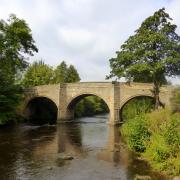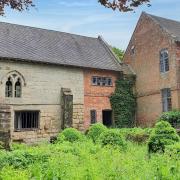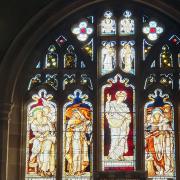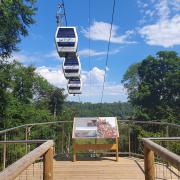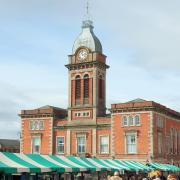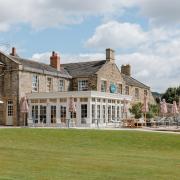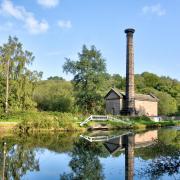There’s something about abandoned sites that is incredibly evocative.
Whether it’s a once-grand stately home clinging onto the last remnants of its former beauty, a crumbling castle reduced to its foundations or an old mill standing forgotten, reclaimed by the land it once exploited, these places stir something inside us.
What would this place have looked like in its heyday? Why did it decline? Who lived here? What conversations and events took place here and what were the consequences?
All these questions and more can race through our minds when we come across somewhere irrevocably altered by time and circumstances.
Here are three such Derbyshire sites which, while now abandoned to nature, continue to fascinate and spark our imaginations.

A625 Abandoned Road
Many of Derbyshire’s abandoned places have risen and fallen as a result of societal change. People come and go, circumstances alter and time passes. The result can be a once-prominent structure becoming redundant and falling into disrepair.
This isn’t always the case, though. Sometimes, Mother Nature plays a defining role. Lying below Mam Tor are the remains of a half-mile section of road that acts as a reminder of nature’s power and the unpredictable – albeit beautiful – nature of the Peak District’s topography.
Mam Tor dominates the skyline around this former stretch of road and is often referred to as ‘Shivering Mountain’, given the area’s propensity for landslides.
This A625 road was built in 1819 and is referred to by some locals as the ‘new road’, linking Castleton with Chapel-en-le-Frith.
It crossed the main body of the landslide that created Mam Tor some 4,000 years ago. Landslides plagued the new road in the years following its opening. It was the late 1970s, however, that would seal its fate.
In 1977, a landslide meant the road was limited to single-lane traffic. Two years later, a slow-moving landslide saw it shut completely. It never reopened, the route diverted westwards through Winnats Pass, an ancient packhorse road.
This ill-fated stretch of road has since gradually blended back into the rugged landscape. White lines that once indicated the middle of the road now sprawl haphazardly in all manner of directions.
However, it hasn’t been entirely abandoned to the mercy of the elements. In its dilapidated state the road has become popular with walkers, cyclists and photographers, compelled to explore the bizarre sight of a naturally dismantled road set against a glorious and picturesque backdrop that was, ultimately, the cause of its downfall.

Over Exposed, Bleaklow
Some of the county’s abandoned landmarks are places of sombre and poignant reflection. One such site exists on Bleaklow, one of the Peak District’s highest and most remote points.
It was here on the isolated Dark Peak moors that US Air Force Boeing RB-29A Superfortress came down in difficult conditions in 1948, claiming the lives of all those aboard – eleven crew and two military passengers.
Modified for photographic assignments, the bomber bore the name Over Exposed, having been flown in July 1946 to take images of American nuclear testing at Bikini Atoll. The same aircraft had also helped facilitate the famous Berlin airlift in the same year. For all its international assignments, it would meet its tragic end high up in the Peak District.
The Superfortress had been conducting a routine flight on November 3 1948, departing RAF Scrampton, near Lincoln, at 10:15am en route to the US Air Force base at Burtonwood, 125 miles away.
Relying on instruments far more rudimentary than those found in modern aircraft and hampered by low cloud, the plane made the fatal miscalculation – based on flight time – that they were past the hills of Bleaklow and began to descend.
Around 45 minutes after take-off the aircraft hit Higher Shelf Stones, where it burst into flames and crashed. The remains of the plane were located at around 4.30pm the same day as the light began to fade.
Over 75 years since the tragic event on Bleaklow, debris still lies abandoned. Indeed, a significant amount of the wreckage remains visible, including wing and fuselage sections, the undercarriage and gun turrets as well as the Duplex-Cyclone engines, which sit dramatically where they fell.
The crash scene was still giving up secrets as late as the 1970s, when a local man found a ring at the site. It was later identified as the wedding ring of Captain Tanner and returned to his daughter.
The wreckage has never been moved or cleared since Over Exposed met its end in 1948. At the crash site, an American flag flies as a tribute to those who perished, alongside a memorial, erected in 1988, to honour the crew’s memory.
Over Exposed, sometimes referred to as the ‘Bleaklow Bomber’, was not the first, nor last, aircraft to succumb to harsh and difficult conditions over Bleaklow in the dangerous days before modern navigation technology. It was, however, the incident that has left the most enduring and visible mark.

Oakhurst, Ambergate
The once grand Oakhurst House in Shining Cliff Woods, Ambergate, has the rather depressing distinction of having never really being wanted by its intended residents.
The brainchild of wealthy industrialist and politician Francis Hurt (1801–54), a figurehead of the influential Hurt dynasty, Oakhurst was the product of both practical thinking and Hurt’s desire to ensure his four daughters would be secure upon his death.
It’s a curiosity that despite the Hurts’ astonishing success at marrying into upper echelons of well-established and influential Derbyshire families in the 1700s and 1800s, including the Gells of Wirksworth, Strutts of Belper, Harpurs of Calke Abbey and Arkwrights of Cromford, the four daughters of Francis Hurt remained unmarried throughout their lives – rare in such times.
As grand as Oakhurst was in its heyday, it was never destined to be a happy home, not by the Hurts anyway.
Originally a forge house, Oakhurst was renovated by Hurt to the tune of £1,000 and leased to iron master William Henry Mold after his father and former iron master Charles Mold had died there, pre-renovation, in 1846.
Mold occupied Oakhurst and the accompanying forge until 1859. By this point, Francis Hurt was dead and his daughters – Fanny, Emma, Elizabeth and Selina – had long since made their intentions clear that none wished to move into the property.
When Mold’s time at Oakhurst came to an end in 1859, the coming years became a precursor to what would ultimately follow. For almost two decades the mansion house stood unused, remaining under the ownership of the family, but redundant as a residence.
However, Oakhurst would benefit from a renaissance and go on to grow in stature before its eventual demise.
Having left the hands of the Hurt family in 1888, Oakhurst passed to the Midland Railway, where extensions were made in order for the company’s chief engineer to make it his residence.
Five years later it was to change hands once more, purchased by Thewlis Johnson, the nephew element in Ambergate-based Richard Johnson and Nephew Wire Works Company, which had set up a base on the site.
Oakhurst took on numerous incarnations in the decades to follow, remaining in the hands of the company for 103 years.
In Thewlis Johnson, who would reside there until his death in 1896, Oakhurst appears to have enjoyed a period of good fortune. Johnson, like Francis Hurt, was influential in local circles and turned the forge next to Oakhurst into a successful subsidiary of Richard Johnson and Nephew – Ambergate Wire Works.
It was he who extended Oakhurst, resulting in the neo-Jacobean style it resembles today, albeit it in a highly dilapidated state.
His imprint on the house, in the form of his stone-carved initials, survive. Certainly, evidence from the early parts of the 20th century show a mansion that appears well loved, standing resplendent within the woods.
By the 1920s Oakhurst was benefiting from both its secluded location and convenient transport links and the area evolved to become a place of solace, with Oakhurst House providing a focal point.
Specifically, it became a retreat for the Diocese of Southwell, with the largest room on the second floor transformed into a chapel. The property was later utilised as a summer school and even a conference venue.
However, international forces indirectly brought an end to Oakhurst’s days as a rural paradise. Following the fallout of the Second World War, the mansion was subsequently again modified: divided into flats to house workers of the wireworks at a time when housing was in short supply.
However, time was catching up with Oakhurst and by the 1970s its increasing wear and tear was beginning to show. This, coupled with more housing options as the post-war recovery continued, saw its residents placed in alternative accommodation.
Never again would Oakhurst be used in any meaningful way and over the past half a century it has fallen further and further into disrepair and now appears unsalvageable from a restoration perspective.
In 1994, plans were put in place to demolish the house; however, that permission has since expired, meaning Oakhurst still stands in Shining Cliff Woods – abandoned, structurally unsound and fenced off from the public.
Largely out of sight and out of mind, it deteriorates further with each passing year, now far more famous for its current state than the varied and interesting days it once enjoyed.
Abandoned Derbyshire, published by Amberley Publishing, can be ordered at amberley-books.com/abandoned-derbyshire.html or by typing ‘abandoned Derbyshire, Amberley’ into Google.







